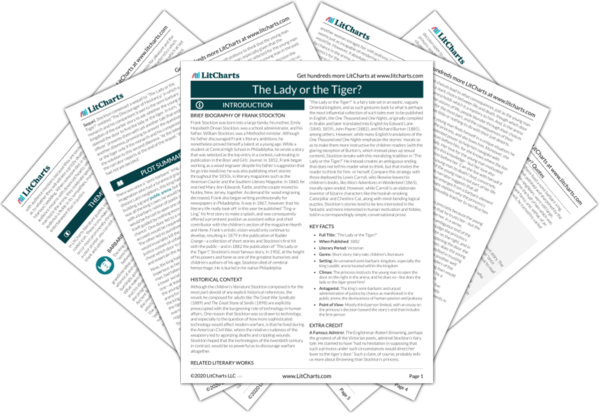The king’s administration of justice rests on a principle not unlike that held by Western civilization, namely, that justice should be blind, impartially administered. However, the king pursues this principle to its logical extreme: in his kingdom, rather than use judges or juries, “the decrees of an impartial and incorruptible chance”—in the form of a public arena in which the accused must choose between two doors, and depending entirely on luck will end up marrying a beautiful lady or be devoured by a hungry tiger. Luck alone determines punishment or reward. Of course, it is true that chance or luck can’t be biased or emotionally manipulated or bribed like human judges can, and in this sense the king’s method is absolutely impartial. However, we might argue nonetheless that chance has nothing to do with justice: after all, in the king’s public arena, a vicious murderer might open the door to a lady, while an innocent person might open the door to a tiger. Even though punishment and reward are impartially rendered in these cases, it is safe to say that they are not justly rendered.
It would seem, then, that no justice system can be absolutely impartial: for justice to be rendered at all, human beings who are by their very nature susceptible to bias must render it. The story investigates this proposition when the princess finds herself in a position to pass judgment on her lover, the young man, who has been accused of a crime and made to face the trial of the public arena. The Princess, in this case, has found out which door in the arena leads to punishment (the tiger) and which to reward (the lady). Yet just as chance is absolutely impartial, so is the princess absolutely biased and deeply conflicted in her interests. On the one hand, she loves the young man and despairs at the thought of his bloody painful death; on the other hand, the idea that her lover should marry another woman enrages her with jealousy. Given this, she seems just as incapable of rendering justice as pure chance would be. However, if absolute impartiality, such as that offered by chance in the arena, and passionate love, such as the princess’s for the young man, both compromise justice, where is justice to be found in this world at all? The story does not answer this question.
Justice, Impartiality, and Bias ThemeTracker

Justice, Impartiality, and Bias Quotes in The Lady or the Tiger?
The arena of the king...with its encircling galleries, its mysterious vaults, and its unseen passages, was an agent of poetic justice, in which crime was punished, or virtue rewarded, by the decrees of an impartial and incorruptible chance.
The decisions of this tribunal [held in the public arena] were not only fair, they were positively determinate: the accused person was instantly punished if he found himself guilty, and, if innocent, he was rewarded on the spot, whether he liked it or not. There was no escape from the judgments of the king's arena.
Of course, everybody knew that the deed with which the accused was charged had been done. He had loved the princess, and neither he, she, nor any one else, thought of denying the fact; but the king would not think of allowing any fact of this kind to interfere with the workings of the tribunal, in which he took such great delight and satisfaction. No matter how the affair turned out, the youth would be disposed of, and the king would take an aesthetic pleasure in watching the course of events…
She knew in which of the two rooms, that lay behind those doors, stood the cage of the tiger, with its open front, and in which waited the lady… Gold, and the power of a woman’s will, had brought the secret to the princess.
The only hope for the youth in which there was any element of certainty was based upon the success of the princess in discovering this mystery; and the moment he looked upon her, he saw she had succeeded, as in his soul he knew she would succeed.
















